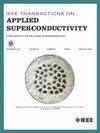时钟跟随数据的延迟平衡:优化鲁棒快速单通量量子电路的区域延迟权衡
IF 1.7
3区 物理与天体物理
Q3 ENGINEERING, ELECTRICAL & ELECTRONIC
引用次数: 0
摘要
本文提出了一种用于合成时钟跟随数据设计的算法,该算法为快速单通量量子(RSFQ)电路提供抗时序违规的鲁棒性,在给定性能约束下最大限度地减少面积成本。由于所有RSFQ逻辑门都必须进行时钟处理,因此对数据流进行正确排序是一个具有挑战性的问题,通常需要插入许多路径平衡D触发器(dff),从而导致面积的大幅增加。为了解决这一挑战,我们提出了一种插入dff并安排其时钟到达时间的方法,部分平衡了电路内的延迟。我们的算法在最小化面积开销的同时实现了目标吞吐量。我们的算法可以解释预期的时序变化,并且通过调整时钟网络和时钟频率的偏置,所得到的电路可以调整意外的时序违规后制作。我们用标称延迟的基准套件量化了我们方法的好处,与高频全径平衡设计相比,我们的区域延迟产品(ADP)平均提高了1.48倍,与SOTA多相时钟解决方案提供的最先进(SOTA)鲁棒电路相比,ADP平均提高了2.07倍。本文章由计算机程序翻译,如有差异,请以英文原文为准。
Delay Balancing With Clock-Follow-Data: Optimizing Area Delay Tradeoffs for Robust Rapid Single Flux Quantum Circuits
This article proposes an algorithm for synthesis of clock-follow-data designs that provide robustness against timing violations for rapid single-flux quantum (RSFQ) circuits, minimizing area costs subject to a given performance constraint. Since all RSFQ logic gates must be clocked, properly sequencing the data flow is a challenging problem that often requires the insertion of many path balancing D flip-flops (DFFs), leading to a substantial increase in area. To address this challenge, we present an approach to insert DFFs and schedule their clock arrival times, partially balancing the delays within the circuit. Our algorithm achieves a target throughput while minimizing area overhead. Our algorithm can account for expected timing variations and, by adjusting the bias of the clock network and clock frequency, the resulting circuits can adjust for unexpected timing violations postfabrication. Quantifying the benefits of our approach with a benchmark suite with nominal delays, we yield an average 1.48x improvement in area delay product (ADP) over high frequency full path balancing designs and a 2.07x improvement in ADP over the state-of-the-art (SOTA) robust circuits provided by SOTA multiphase clocking solutions.
求助全文
通过发布文献求助,成功后即可免费获取论文全文。
去求助
来源期刊

IEEE Transactions on Applied Superconductivity
工程技术-工程:电子与电气
CiteScore
3.50
自引率
33.30%
发文量
650
审稿时长
2.3 months
期刊介绍:
IEEE Transactions on Applied Superconductivity (TAS) contains articles on the applications of superconductivity and other relevant technology. Electronic applications include analog and digital circuits employing thin films and active devices such as Josephson junctions. Large scale applications include magnets for power applications such as motors and generators, for magnetic resonance, for accelerators, and cable applications such as power transmission.
 求助内容:
求助内容: 应助结果提醒方式:
应助结果提醒方式:


